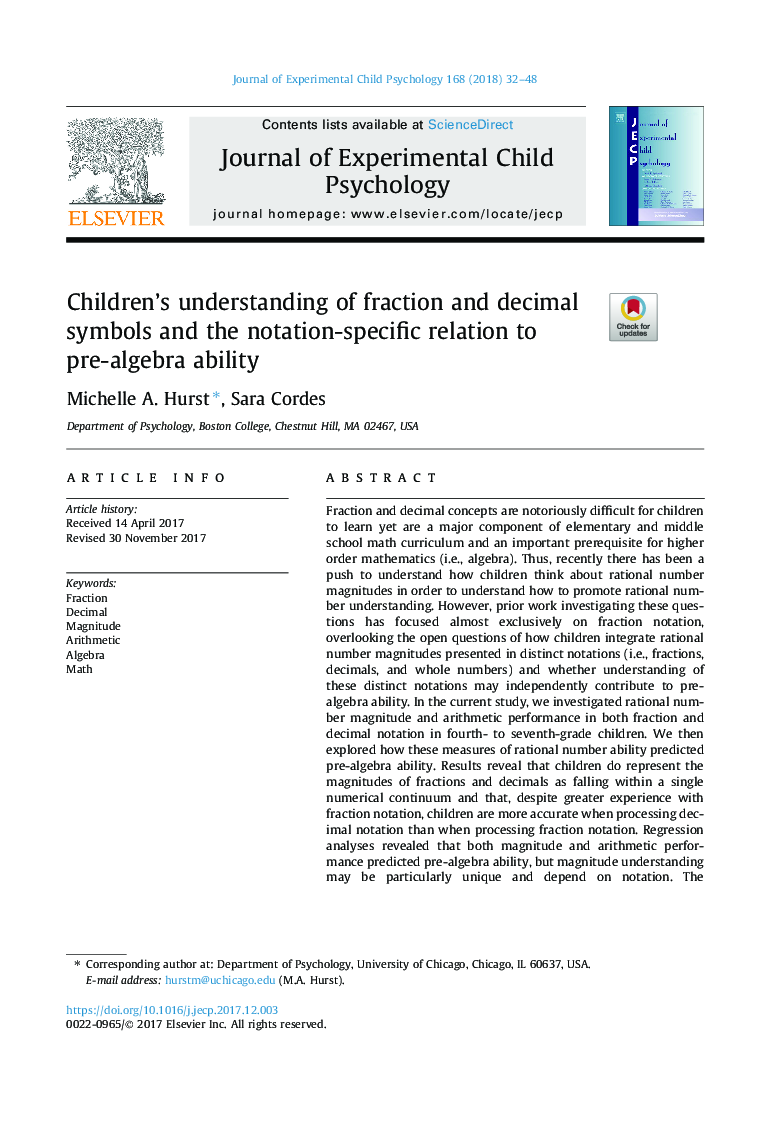| کد مقاله | کد نشریه | سال انتشار | مقاله انگلیسی | نسخه تمام متن |
|---|---|---|---|---|
| 7274057 | 1473444 | 2018 | 17 صفحه PDF | دانلود رایگان |
عنوان انگلیسی مقاله ISI
Children's understanding of fraction and decimal symbols and the notation-specific relation to pre-algebra ability
ترجمه فارسی عنوان
درک کودکان از نمادهای کسر و نماد و رابطه خاص نمایندگی با توانایی قبل از جبر
دانلود مقاله + سفارش ترجمه
دانلود مقاله ISI انگلیسی
رایگان برای ایرانیان
کلمات کلیدی
کسر، دهکده، اندازه، ریاضیات، جبر ریاضی،
ترجمه چکیده
مفاهیم فراوانی و اعشاری برای دانش آموزان بسیار دشوار است اما جزء اصلی برنامه درسی ریاضی ابتدایی و متوسطه و یک پیش نیاز مهم برای ریاضیات بالاتر (به عنوان مثال، جبر) است. بنابراین اخیرا فشار برای فهمیدن اینکه چگونه کودکان درمورد مقادیر عقلانی فکر می کنند، به منظور درک چگونگی ترویج درک عدالت عقلانی وجود دارد. با این حال، کار قبلی تحقیق در این سوالات تقریبا به طور انحصاری بر روی نماد کسری متمرکز شده است، با نگاهی به سوالات باز از این که چگونه کودکان مقادیر عقلایی ارائه شده در نشانه های متمایز (یعنی تقسیمات، اعشار و اعداد کامل) را ادغام می کنند و اینکه آیا درک این نشانه های متمایز ممکن است مستقل باشد به توانایی پیش جبر کمک می کند. در تحقیق حاضر، مقدار عقلایی و عملکرد ریاضی در هر دو ضلع و علامت دهی در فرزندان چهارم تا هفتم بررسی شده است. سپس ما بررسی کردیم که چگونه این اندازه گیری ها از توانایی های عقلانی پیش بینی توانایی پیش جبر را پیش بینی می کنند. نتایج نشان می دهد که کودکان نشان دهنده مقادیر کسر ها و دقایق ها به عنوان در حال سقوط در یک حلقه عددی واحد هستند و با وجود تجربه بیشتر با نماد کسری، کودکان هنگام دقیق تر کردن عبارات دقت نسبت به پردازش ضریب کسری، دقت بیشتری دارند. تجزیه و تحلیل رگرسیون نشان داد که هر دو اندازه و عملکرد ریاضی توانایی قبل از جبر را پیش بینی می کنند، اما درک بزرگ می تواند به طور خاص منحصر به فرد و وابسته به نشانه باشد. مفاهیم آموزشی تفاوت های کودکان در مطالعه فعلی و کار قبلی با بزرگسالان مورد بحث قرار گرفته است.
موضوعات مرتبط
علوم انسانی و اجتماعی
روانشناسی
روانشناسی رشد و آموزشی
چکیده انگلیسی
Fraction and decimal concepts are notoriously difficult for children to learn yet are a major component of elementary and middle school math curriculum and an important prerequisite for higher order mathematics (i.e., algebra). Thus, recently there has been a push to understand how children think about rational number magnitudes in order to understand how to promote rational number understanding. However, prior work investigating these questions has focused almost exclusively on fraction notation, overlooking the open questions of how children integrate rational number magnitudes presented in distinct notations (i.e., fractions, decimals, and whole numbers) and whether understanding of these distinct notations may independently contribute to pre-algebra ability. In the current study, we investigated rational number magnitude and arithmetic performance in both fraction and decimal notation in fourth- to seventh-grade children. We then explored how these measures of rational number ability predicted pre-algebra ability. Results reveal that children do represent the magnitudes of fractions and decimals as falling within a single numerical continuum and that, despite greater experience with fraction notation, children are more accurate when processing decimal notation than when processing fraction notation. Regression analyses revealed that both magnitude and arithmetic performance predicted pre-algebra ability, but magnitude understanding may be particularly unique and depend on notation. The educational implications of differences between children in the current study and previous work with adults are discussed.
ناشر
Database: Elsevier - ScienceDirect (ساینس دایرکت)
Journal: Journal of Experimental Child Psychology - Volume 168, April 2018, Pages 32-48
Journal: Journal of Experimental Child Psychology - Volume 168, April 2018, Pages 32-48
نویسندگان
Michelle A. Hurst, Sara Cordes,
